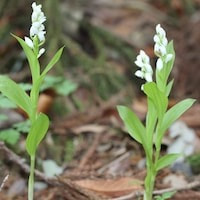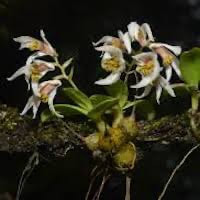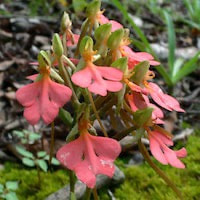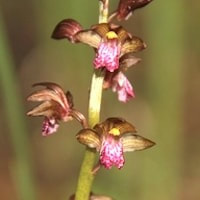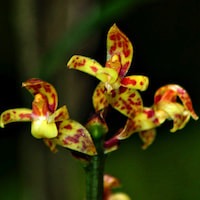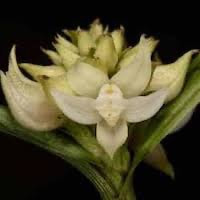WOR4- Women's Oriental 4 - Scent like a million bucks
|
Native Singaporean Orchid notes: Dendrobium Singaporense
Dendrobium Singaporense is a distinctive orchid known for its delicate fragrance, resembling chrysanthemum tea. Native to Singapore, it's named after the country and is endemic there, thriving in unique local conditions. Conservation efforts are crucial due to habitat threats. In fragrance workshops like "Oriental 4 (Women)," its fragrance is used to create perfumes evoking tranquility and elegance. Its appeal lies in its light, beautiful scent, making it a prized ingredient in perfumery and a symbol of Singapore's floral diversity.
|
Therapeutic Orchid notes:
|
Cephalanthera erecta (Thunb.) Blume
Cephalanthera erecta, known as Yin Lan or silver orchid, is esteemed for its delicate fragrance and medicinal benefits. Its scent is described as floral, fresh, and subtly sweet, making it sought after in perfumery. Native to the Eastern Himalaya, China, and Japan, it thrives in shady, damp habitats. In Traditional Chinese Medicine (TCM), Yin Lan is used for its antipyretic properties to reduce fever, alleviate thirst, and treat urinary infections. While its traditional uses are recognized, scientific research is needed to confirm its medicinal efficacy fully. Cephalanthera erecta represents a botanical treasure appreciated for both its fragrance and potential in herbal medicine. |
|
Dendrobium appendiculatum (Blume) Lindl. syn. Flickingeria bifida A. Hawkes; Ephemeranta bifida (Ridley) Hunt et Summerh.
Dendrobium appendiculatum (Blume) Lindl., also known as Claw Dendrobium, has a unique distribution spanning Peninsular Thailand, Peninsular Malaysia, Sumatra, and Java. Specific details about its scent are not readily available, typical for orchids with varied fragrances crucial for attracting pollinators. In Traditional Chinese Medicine (TCM), it's valued for its cooling properties to nourish bodily fluids ("enrich yin"), benefiting conditions of heat and dryness. TCM uses include treating respiratory issues like tuberculous cough and asthma, reflecting its potential for respiratory health. Scientific research is needed to validate its medicinal properties and ensure safe usage. Conservation efforts are essential due to threats from habitat loss and overexploitation, preserving biodiversity and cultural heritage associated with orchids. |
|
Habenaria rhodocheila Hance
Habenaria rhodocheila Hance, known as Chenghuangyufeng Hua in Chinese, is an orchid species found in Southeast Asia, including regions like Hainan, Guangdong, and Hong Kong. Specific details about its scent are unavailable, common for orchids with varying fragrances. In Traditional Chinese Medicine (TCM), it is used to treat finger ulcers and conditions related to body heat or inflammation, employing a decoction of 3–9 grams of the herb. While traditional uses provide insights, scientific research is necessary to confirm its efficacy and safety. Habenaria rhodocheila's ornamental value is also noted, especially in Thai and Malaysian varieties known for more flowers and intense colors, making them popular in horticulture. |
|
Oreorchis foliosa (Lindl.) Lindl.
Oreorchis foliosa (Lindl.) Lindl., known as Xiaoshan Lan or Nangchunshan Lan in Chinese, is a terrestrial orchid found across Japan, Taiwan, and various regions of China, India, and neighboring countries. Its specific scent details are not documented, typical for orchids with diverse fragrances. In Traditional Chinese Medicine (TCM), the stem of Oreorchis foliosa is utilized to counteract snake bites and treat conditions like tuberculosis of lymph nodes, sores, and ulcers. However, while traditional uses provide insights, scientific research is essential to verify their efficacy and safety. Conservation efforts are crucial to protect Oreorchis foliosa from habitat destruction and over-collection, ensuring its ecological role and biodiversity preservation in its natural habitats. |
|
Plocoglottis javanica Blume Pocoglottis fimbriata Teijsm & Binn.
Information on the specific scent of Plocoglottis javanica Blume and Plocoglottis fimbriata Teijsm & Binn is not readily available. Orchid scents vary widely; some have pleasant fragrances, while others may be less noticeable. This hybrid has a pleasant scent inconsistently. Scentopia uses these notes, extracted through original methods, to recreate the fragrance in a lab. Historical records mention Plocoglottis javanica's fruit juice treating earaches. While traditional uses offer insights, scientific research is vital to confirm efficacy and safety. Conservation efforts are critical to protect these orchids from habitat loss and over-collection, ensuring their survival and biodiversity in their native environments. |
|
Tropidia curculigoides Lindl. Syn. Tropidia graminea Bl.; T. formosana Rolfe;Tropidia curculigoides, known for its bamboo-like appearance, features large, lanceolate leaves spaced along its upright stem. Found across India, Bhutan, Southeast Asia, and Australia, its flowering times vary by region, occurring from May to November. Traditionally, its decoction treats malaria in Malaysia, India, and Bangladesh, while its roots are used for diarrhea. While traditional uses offer insights, scientific research is needed to confirm efficacy. Conservation efforts are crucial to protect Tropidia curculigoides and its habitats, ensuring biodiversity and sustainability.
|
Other scent note
Scentopia Library Reference ingredient
Thai Basil - Sir Raffles Collection - Check details at Scentopia's scent library
Download the guided mediation that works best with this Orchid fragrance oil
| women_oriental_essential_oil_orchi_00004.mp3 | |
| File Size: | 90857 kb |
| File Type: | mp3 |

